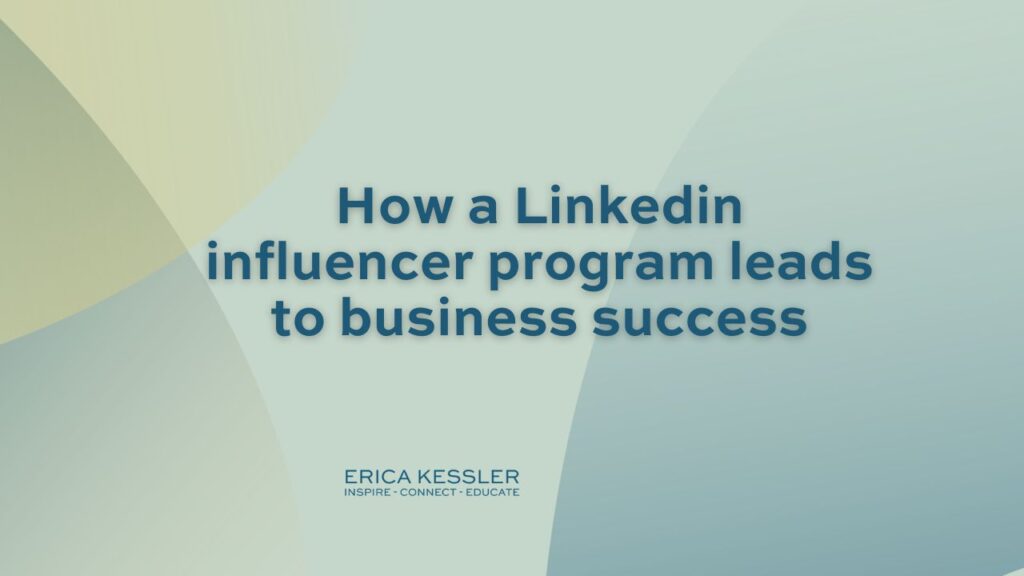How a Linkedin influencer program leads to business success

With employee advocacy, companies can achieve measurable results by influencing and getting reach globally – through the development of trusting employees and appropriate marketing and networking strategies. How can the right target audience be influenced? Implementing a strategy, empowering, training and educating the CEO, executives and your employees is what leads to success.
I am repeatedly asked by CEOs, HR, Marketing and Communication leaders how to implement an influencer/employee advocacy program. What I hear all the time is “We are interested in one training or one speech.”. The simplest answer is: this will not work and lead to success. The question to be asked: is the company reputation and the reputation of your employees important? Then don’t ruin it, because you never can fix it again. It’s worth its weight in gold to do it with a high-quality and step-by-step approach.
Those who make an effort to present themselves well now will have competitive advantages globally.
Anyone who doesn’t live in the Swiss mountains or far from civilization will find that social media has fundamentally changed. The fundamentals are key. It needs to be strategic, professional and authentic, with no automatization. I can tell you that otherwise it will not work.
Influencer marketing and employee advocacy are for businesses that want to:
- Strengthen their brand and tell their company story
- Strengthen their employer branding – Dive deep into the culture
- Build a strategic and strong personal brand
- Spread awareness and increase the know, like and trust factor
- Attract new talent – active or passive job seekers
- Get more reach and build trust with clever content marketing posts and Linkedin articles
- Enlarge their network globally ethically and with quality
- Build relationships with some followers and their network
- Promote new products, store openings, events or exhibitions
- And much more
Convince the CEO
Did you know that it all starts with the CEO? There are of course exceptions.
And yes: in theory, this all sounds simple. But practice is complex and shows: before an influencer program can be successfully rolled out on a business platform like LinkedIn, it first needs a strategy with smart, actionable goals and a good, consistent strategy. This also means the approval and support of senior management are absolutely essential. If there is no or too little know-how about the possibilities with Linkedin at the top management level of a company, the experts within the company first need to be convinced. To this end, it makes sense to seek allies within the company, whether it be the CFO, human resources, marketing, communications or specialist departments.
“The CEO must stand behind influencer marketing with Linkedin and support the strategy.”
In conclusion: the CEO must stand behind influencer marketing with Linkedin and support the strategy. In the best case, the CEO and their assistant will be trained and coached in Linkedin to position in a strategic and authentic way and to get familiar with the platform. The employees are inspired and some follow the CEO. Educate the CEO (and their assistant or communication expert). It’s best to get an external expert.
Define your strategy, goals and start with the program
First, define your strategy with tactics and understand the different topics of employee advocacy, such as:
- KPIs with tracking
- Social media netiquette and Linkedin terms
- How the employer branding is connected with the employee’s personal brand
- How a strategic personal brand can be built and why visuals and text matter
- Define a content strategy with relevant tactics
- Define a global network strategy
- And much more
Don’t underestimate the core team training
A core team should be defined and trained so that they understand the platform. They are also a model and a so-called Linkedin influencer. They will be ahead of everyone and inspire.
It takes several trainings to understand how Linkedin works. First, optimize the personal profiles, then engage in strategic content sharing and building a global relevant network. To empower, educate and give courage, an external expert is helpful to be efficient and more successful. An external view and having a sparring partner helps the business too. This is what I hear all the time. And to ensure the highest quality, consulting and knowledge transfer are needed, such as how to check the profile and give feedback, inspiration and courage.
“A core team should be defined and trained so that they are a role model and understand the platform”.
Always keep the reputation of your organization and your employees as the top priority
This is underestimated; organizations are usually not thinking about their reputation. Linkedin, as the largest global business platform, has reach you could not imagine, but the downside is also the potential harm of the reputation of both the company and your personal brand. Once you have harmed your reputation, it is not possible anymore to fix it 100%. That’s why a social media netiquette is key.
The right mindset is key for getting out of the comfort zone
Too many employees think that Linkedin is similar to other social media platforms. I can tell you that it is not. It needs a business mindset: courage and professionalism are key.
“The most important part is the company and employee’s reputation.”
This needs time. Some employees are ahead of others and inspire with their success. When they get great job applications, a hot lead and a good number of views of their post, others want to achieve this too. And yes, it works. And yes, it always works.
What content to share and how?
To share relevant content in the newsfeed one needs knowledge, courage and sometimes to just do it (but professionally). To re-share a post from the company page by adding a positive opinion or expertise is a good start. To comment on an experts post is another way. Or just share a poll or an internal or external event experience. Start simple. You do not need to write a Linkedin article from the beginning.
Measure the Linkedin influencer program
The CEO, Board or CFO is interested in success. That is why the analytics, successes and challenges will be reported frequently.
Get all employees on board
Go Switzerland-wide or global. Empower your employees with a speaking engagement and get everyone on board. It’s worth its weight in gold.
To summarize the key points
Define your influencer program strategy, get the CEO on board, train a pilot team first and inspire the employees. Do it professionally, authentically, get out of the comfort zone and have the right business mindset. Good luck and have fun.

Linkedin company page
Case Study “Linkedin Corporate Influencer Program” Victorinox AG
A successful Linkedin Influencer Program supports the global brand awareness of Victorinox AG. The traditional Swiss company from Ibach/SZ has the courage and invests in its employees and leverages the power of the global business network.
In spring 2020, the Influencer Program started, which is managed by Nina Finkbohner-Keller and Alexandra Hinz. In March 1, 2023, an important milestone was communicated and celebrated: With around 30 Corporate Influencers from the HQ functions Marketing, HR, Product, Sales, Travel, Travel Retail, Supply Chain and Digital Business Transformation, a reach of over one million was achieved. In 2024, the Linkedin Corporate Influencer Program will also be rolled out in selected subsidiaries.

Corporate Influencer training in Ibach/SZ, Switzerland
My questions to you:
Does the company you work for have an employee advocacy or influencer program? What are your experiences? If your company does not yet have a program: why not?
I look forward to the dialog via e-mail: hello@erica-kessler.com. Thank you very much.
This article has been originally published on Linkedin.
Erica Kessler
I’m the founder of Social Media Leaders GmbH and I’m a Linkedin marketing strategist, trainer, guest lecturer at Swiss Universities and speaker. I train and educate organizations to use Linkedin influencer or employee advocacy programs successfully.
